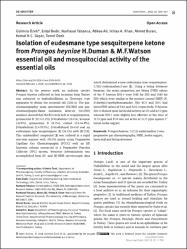Isolation of eudesmane type sesquiterpene ketone from Prangos heyniae H.Duman & MFWatson essential oil and mosquitocidal activity of the essential oils

View/
Access
info:eu-repo/semantics/openAccessDate
2018Author
Özek, GülmiraBedir, Erdal
Tabanca, Nurhayat
Ali, Abbas
Khan, Ikhlas A.
Duran, Ahmet
Özek, Temel
Metadata
Show full item recordAbstract
In the present work, an endemic species Prangos heyniae collected in four locations from Turkey was subjected to hydrodistillation in Clevenger type apparatus to obtain the essential oils (E01-4). The gas chromatography/mass spectrometry (GC/MS) and gas chromatography-flame ionization detector (GC/FID) analyses showed that the EOs were rich in sesquiterpenes, germacrene D (10.3-12.1%), beta-bisabolene (14.4%), kessane (26.9%), germacrene B (8.2%), elemol (3.4-46.9%), beta-bisabolenal (14-70.7%), beta-bisabolenol (8.4%) and an eudesmane type sesquiterpene (1) (16.1%) with [M(+)218]. This unidentified compound (1) was isolated in a rapid one-step manner with >95.0% purity using Preparative Capillary Gas Chromatography (PCGC) with an HP Innowax column connected to a Preparative Fraction Collector (PFC) system. Structure determination was accomplished from 1D- and 2D-NMR spectroscopic data which determined a new eudesmane type sesquiterpene, 3,7(11)-eudesmadien-2-one (1). Using a biting deterrent bioassay, the mean proportion not biting (PNB) values of the P. heyniae E01-4 were 0.88 for E01 and 0.80 for E02 which were similar to the positive control DEET (N, N-diethyl-3-methylbenzamide). The E03 and E04 had lower PNB values of 0.64 and 0.44, respectively. P. heyniae E01-4 showed good larvicidal activity at 125 and 62.5 ppm whereas E01-3 were slightly less effective at the dose of 31.25 ppm and E04 was not active at 31.25 ppm against 1st instar Aedes aegypti.
Source
Open ChemistryVolume
16Issue
1Collections
- Makale Koleksiyonu [488]
- Scopus İndeksli Yayınlar Koleksiyonu [8325]
- WoS İndeksli Yayınlar Koleksiyonu [7605]

















